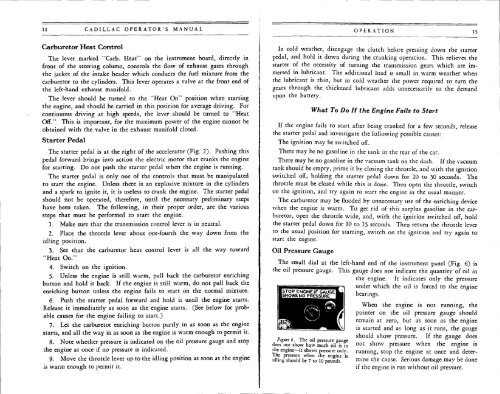1928 Cadillac - GM Heritage Center
1928 Cadillac - GM Heritage Center
1928 Cadillac - GM Heritage Center
You also want an ePaper? Increase the reach of your titles
YUMPU automatically turns print PDFs into web optimized ePapers that Google loves.
14 CADILLAC OPERATOR'S MANUAL<br />
OPERATION 15<br />
Carburetor Heat Control<br />
The lever marked "Carb. Heat" on the instrument board, directly in<br />
front of the steering column, controls the flow of exhaust gases through<br />
the jacket of the intake header which conducts the fuel mixture from the<br />
carburetor to the cylinders. This lever operates a valve at the front end of<br />
the left-hand exhaust manifold.<br />
The lever should be turned to the "Heat On" position when starting<br />
the engine, and should be carried in this position for average driving. For<br />
continuous driving at high speeds, the lever should be turned to "Heat<br />
Off." This is important, for the maximum power of the engine cannot be<br />
obtained with the valve in the exhaust manifold closed.<br />
Starter Pedal<br />
The starter pedal is at the right of the accelerator (Fig. 2). Pushing this<br />
pedal forward brings into action the electric motor that cranks the engine<br />
for starting. Do not push the starter pedal when the engine is running.<br />
The starter pedal is only one of the controls that must be manipulated<br />
to start the engine. Unless there is an explosive mixture in the cylinders<br />
and a spark to ignite it, it is useless to crank the engine. The starter pedal<br />
should not be operated, therefore, until the necessary preliminary steps<br />
have been taken. The following, in their proper order, are the various<br />
steps that must be performed to start the engine.<br />
1. Make sure that the transmission control lever is in neutral.<br />
2. Place the throttle lever about one-fourth the way down from the<br />
idling position.<br />
3. See that the carburetor heat control lever is all the way toward<br />
"Heat On."<br />
4. Switch on the ignition.<br />
5. Unless the engine is still warm, pull back the carburetor enriching<br />
button and hold it back. If the engine is still warm, do not pull back the<br />
enriching button unless the engine fails to start on the normal mixture.<br />
6. Push the starter pedal forward and hold it until the engine starts.<br />
Release it immediately as soon as the engine starts. (See below for probable<br />
causes for the engine failing to start.)<br />
7. Let the carburetor enriching button partly in as soon as the engine<br />
starts, and all the way in as soon as the engine is warm enough to permit it.<br />
8. Note whether pressure is indicated on the oil pressure gauge and st6p<br />
the engine at once if no pressure is indicated.<br />
9. Move the throttle lever up to the idling position as soon as the engine<br />
is warm enough to permit it.<br />
In cold weather, disengage the clutch before pressing down the starter<br />
pedal, and hold it down during the cranking operation. This relieves the<br />
starter of the necessity of turning the transmission gears which are immersed<br />
in lubricant. The additional load is small in warm weather when<br />
the lubricant is thin, but in cold weather the power required to turn the<br />
gears through the thickened lubricant adds unnecessarily to the demand<br />
upon the battery.<br />
What To Do If the Engine Fails to<br />
Start<br />
If the engine fails to start after being cranked for a few seconds, release<br />
the starter pedal and investigate the following possible causes:<br />
The ignition may be switched off.<br />
There may be no gasoline in the tank in the rear of the car.<br />
There may be no gasoline in the vacuum tank on the dash. If the vacuum<br />
tank should be empty, prime it by closing the throttle, and with the ignition<br />
switched off, holding the starter pedal down for 20 to 30 seconds. The<br />
throttle must be closed while this is done. Then open the throttle, switch<br />
on the ignition, and try again to start the engine in the usual manner.<br />
The carburetor may be flooded by unnecessary use of the enriching device<br />
when the engine is warm. To get rid of this surplus gasoline in the carburetor,<br />
open the throttle wide, and, with the ignition switched off, hold<br />
the starter pedal down for 10 to 15 seconds. Then return the throttle lever<br />
to the usual position for starting, switch on the ignition and try again to<br />
start the engine.<br />
Oil Pressure Gauge<br />
The small dial at the left-hand end of the instrument panel (Fig. 6) is<br />
the oil pressure gauge. This gauge does not indicate the quantity of oil in<br />
the engine. It indicates only the pressure<br />
under which the oil is forced to the engine<br />
bearings.<br />
When the engine is not running, the<br />
pointer on the oil pressure gauge should<br />
remain at zero, but as soon as the engine<br />
is started and as long as it runs, the gauge<br />
,,. , _, ., should show pressure. If the gauge does<br />
Figure 6. The oil pressure gauge , . . ° .<br />
not<br />
does not show how much oil is in show pressure when the engine is<br />
the engine—it shows pressure only, running, stop the engine at once and deterlhc<br />
pressure when the engine is mme • ? „ . , .<br />
idling should be 7 to 10 pounds.<br />
tne cause. Serious damage may be done<br />
if the engine is run without oil pressure.
















